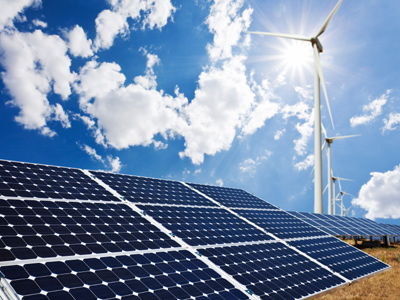
Ask the AI Tutor
Need help with Physics - Electricity from the Sun, Wind and Water (AQA)? Ask our AI Tutor!
AI Tutor - Lucy
Connecting with Tutor...
Please wait while we establish connection

Solar cells and wind farms are both alternative sources of power.
Physics - Electricity from the Sun, Wind and Water (AQA)
Discover how sunlight, wind and moving water can generate electricity, and compare these renewable resources with fossil fuels in your GCSE Physics energy studies.
1 .
Which system generates electricity directly from the Sun's radiation?
Hydroelectric power
Solar panels
Tidal power
Photovoltaic cells
This is another name for solar cells. It is easy to confuse solar cells with solar panels which produce hot water and not electricity
2 .
Where does the energy for tidal power stations come from?
Other power stations
The gravitational attraction of the Sun and Moon
The wind
Ships passing by and creating waves
The tides are created by the gravitational attraction of the Sun and Moon on the oceans of the Earth. There is a high tide once every 12 hours
3 .
Which of the following would be a good source of electrical energy for a remote place?
A roof made from solar cells
A wind turbine
A hydroelectric system
All of the above
These are all good ways of providing electricity for remote locations. It is always best if several methods are used together so that there will always be electricity generated
4 .
Geothermal energy is obtained by using steam that comes from under the ground. Where does the heat energy come from that creates the steam?
From the Sun heating the ground
From fossil fuels that have been set alight by volcanoes underground
From radioactive decay deep inside the Earth
From earthquakes
As you go deeper into the Earth the the rocks get hotter. This heat comes from the decay of radioactive minerals deep inside the Earth
5 .
What is the name given to the source of energy created by the burning of gas from decaying plant or animal waste?
Ecomass
Biomass
Thermalmass
Poogas
Not only is this a renewable energy resource, it also gets rid of waste in a useful way
6 .
What term is used to describe energy resources that will always be available?
Renewable
Finite
Eco
Infinite
At some point in the future, fossil fuel supplies will be used up. They took millions of years to form and humans will have used them all up in a few hundred years
7 .
Which energy source comes from the movement of sea water flowing through turbines to generate electricity?
Tidal power
Hydroelectric power
Wave power
Geothermal power
At high tide the dam is closed, trapping the water behind it. At low tide it is opened and the water behind the dam can flow back to the sea through the turbines, generating electricity
8 .
Choose the answer that contains the missing words in the correct order.
Convection _________ in the Earth's atmosphere give rise to the wind. These are created by ______ energy from the Sun warming up the surface of the Earth. Wind _________ have large blades that are connected to gears linked to a __________. The _________ energy of the wind is transferred into electrical energy.
Convection _________ in the Earth's atmosphere give rise to the wind. These are created by ______ energy from the Sun warming up the surface of the Earth. Wind _________ have large blades that are connected to gears linked to a __________. The _________ energy of the wind is transferred into electrical energy.
cells, generator, turbines, heat, turning
circles, kinetic, turbines, generator, electrical
currents, heat, turbines, generator, kinetic
currents, light, generators, dynamo, chemical
Wind power can be traced back to the Sun and it is for that reason it is a renewable source of energy
9 .
Which of the following describes the energy changes in a pumped storage hydroelectric system?
potential → kinetic → electrical
electrical → kinetic → potential → kinetic → electrical
chemical → potential → kinetic → electrical
chemical → potential → electrical → kinetic → electrical
Water is pumped to a higher reservoir using off-peak electricity that would otherwise be unused. The water can then be released at peak times to be sent through the national grid
10 .
In photovoltaic cells on what does the amount of electricity produced depend??
The amount of electricity produced depends only on the light intensity
The amount of electricity produced depends only on the size of the photovoltaic cell
The amount of electricity produced depends on both the light intensity and size of the photovoltaic cell
The amount of electricity produced is the same whatever the light intensity and size of the photovoltaic cell
The brighter the light and the larger the cell, the more electricity is produced
**Unlimited Quizzes Await You! 🚀**
Hey there, quiz champ! 🌟 You've already tackled today's free questions.
Ready for more?
Ready for more?
🔓 Unlock UNLIMITED Quizzes and challenge yourself every day. But that's
not all...
not all...
🔥 As a Subscriber you can join our thrilling "Daily Streak" against other
quizzers. Try to win a coveted spot on our Hall of Fame Page.
quizzers. Try to win a coveted spot on our Hall of Fame Page.
Don't miss out! Join us now and keep the fun rolling. 🎉
**Unlimited Quizzes Await You! 🚀**
Hey there, quiz champ! 🌟 You've already tackled today's free questions. Ready for more?
🔓 Unlock UNLIMITED Quizzes and challenge yourself every day. But that's not all...
🔥 As a Subscriber you can join our thrilling "Daily Streak" against other quizzers. Try to win a coveted spot on our Hall of Fame Page.
Don't miss out! Join us now and keep the fun rolling. 🎉






